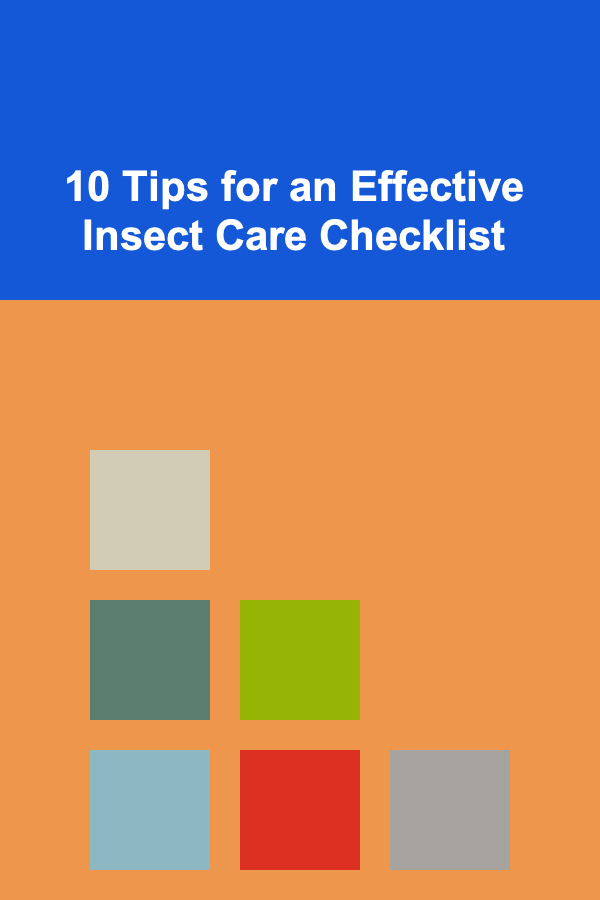
10 Tips for an Effective Insect Care Checklist
ebook include PDF & Audio bundle (Micro Guide)
$12.99$10.99
Limited Time Offer! Order within the next:

Insect care is essential for those who keep insects as pets, study entomology, or even have a fascination with these tiny creatures. Whether you're caring for a pet tarantula, a colony of ants, or butterflies in a garden, proper care is essential to ensure their well-being and longevity. An insect care checklist helps ensure that all the necessary steps are followed to maintain a healthy and thriving environment for your insects.
This article presents 10 essential tips for creating an effective insect care checklist. These tips will help you provide proper care for your insects, address potential issues before they become serious, and make sure you're meeting all their needs.
Know Your Insect's Species and Specific Needs
The first and most important step in caring for insects is understanding the species you are looking after. Different insects have varying care requirements, such as temperature preferences, humidity levels, diet, and habitat conditions.
Action Steps:
- Research: Spend time learning about the species you care for. You can find reliable sources like books, online forums, and research papers.
- Ask Experts: Reach out to entomologists or experienced insect keepers who can offer valuable insights into specific care needs.
Why It Matters:
Knowing your insect's needs ensures that you can provide the appropriate environment and care. For example, a tropical beetle will need higher humidity and warmer temperatures than a desert species.
Create an Optimal Habitat
Every insect species has a specific habitat requirement. This may include things like enclosure size, substrate, hiding spots, and decorations. Some insects prefer vertical space (for climbing), while others prefer horizontal spaces.
Action Steps:
- Choose the Right Enclosure: Select an enclosure that matches your insect's size and behavior. A tank or terrarium should have proper ventilation and be escape-proof.
- Provide Substrate: The substrate should be chosen according to the species---whether it's sand, soil, or leaf litter. This provides a natural environment for insects like beetles or ants.
- Add Hiding Spots and Climbing Structures: Branches, rocks, or plants can serve as hiding spots or climbing surfaces. Ensure the environment mimics the insect's natural habitat.
Why It Matters:
Insects feel safer and are less stressed when their habitat is as close to their natural environment as possible. It also encourages natural behaviors such as burrowing, climbing, and foraging.
Maintain Proper Temperature and Humidity Levels
Temperature and humidity play a crucial role in an insect's health and development. Each species has its own temperature range that is ideal for growth and activity. Too hot or too cold can cause stress, inactivity, or even death. Humidity is just as important for many species, as it affects their ability to molt or reproduce.
Action Steps:
- Monitor Temperature: Use a thermometer to keep track of the enclosure's temperature. Many insect species thrive at room temperature, while others need specialized heating equipment, such as heat lamps or heat pads.
- Control Humidity: Use a hygrometer to measure the humidity. Mist the enclosure if necessary, but avoid excessive moisture, which can lead to mold or fungal growth.
Why It Matters:
Insects are cold-blooded creatures, so their activity levels and metabolism are directly affected by the temperature. For instance, a tarantula requires a warmer environment to maintain its health, while certain types of ants need a specific level of humidity to prevent dehydration.
Establish a Proper Feeding Schedule
Feeding your insects the right food is crucial for their health. The dietary needs of insects vary greatly, from carnivorous species to herbivores, and even omnivores. Proper feeding also includes knowing how often to feed and what types of food to provide.
Action Steps:
- Determine the Diet: Research the appropriate food sources for your insect species. Many insects, such as beetles and crickets, are omnivores, while others, like caterpillars, are herbivores.
- Provide Fresh Food: Remove uneaten food regularly to avoid mold growth and other health issues.
- Supplement with Calcium and Nutrients: Some insects, such as reptiles, need additional supplements for health, such as calcium powder for molting.
Why It Matters:
Proper nutrition is key to ensuring that your insect has the energy it needs for growth, reproduction, and health. A malnourished insect may become weak, have trouble molting, or succumb to illness.
Check for Signs of Illness or Stress
Insects, like any other pet, can suffer from illness or stress. It's important to observe your insect regularly for signs of distress, including unusual behavior, poor mobility, or physical deformities.
Action Steps:
- Observe Behavior: Look for signs of lethargy, abnormal movement, or lack of appetite.
- Inspect for Physical Issues: Check your insect for any visible injuries, parasites, or deformities.
- Act Quickly: If you notice any signs of illness or stress, take immediate action. This may include adjusting habitat conditions, providing medical treatment (if necessary), or isolating the insect from others.
Why It Matters:
Catching potential issues early can prevent serious illness or death. Healthy insects tend to be more active and exhibit normal behavior, while stressed or sick insects often hide or fail to eat.
Provide Safe and Proper Water Sources
Water is essential for most insects, though the type of water source can vary depending on the species. Some insects prefer to drink from shallow water dishes, while others, such as desert species, need only minimal moisture.
Action Steps:
- Shallow Water Dishes: Use shallow water containers to avoid drowning. For insects that prefer moisture, you can use a sponge soaked with water, or mist the enclosure.
- Change Water Regularly: Clean the water containers regularly to prevent bacterial growth or mold.
Why It Matters:
Insects need water to stay hydrated and maintain their bodily functions. Without sufficient hydration, they can become weak or die. However, be careful not to create an environment where they could drown or become excessively wet.
Monitor for Pests or Contaminants
Sometimes, pests or contaminants can affect the health of your insects. These may include mites, mold, or other harmful organisms. Monitoring your insect habitat regularly will help you catch these issues early.
Action Steps:
- Inspect for Mites or Parasites: Regularly check for tiny mites, molds, or other pests that can harm your insect.
- Use Insecticidal Solutions Carefully: If pests are detected, use insecticidal solutions that are safe for the specific type of insect you're keeping.
Why It Matters:
Pests or contaminants can lead to disease, stress, or death for your insects. Regular monitoring and prompt treatment can prevent these issues from escalating.
Provide the Right Lighting and Photoperiod
Lighting is another environmental factor that can affect the well-being of insects. Some insects require specific lighting conditions to regulate their circadian rhythms, while others may be sensitive to light exposure.
Action Steps:
- Use UV Lighting if Needed: Certain species, like mantises and some beetles, may require ultraviolet (UV) light to thrive.
- Adjust Day/Night Cycles: Ensure that your insect has a proper day and night cycle. You can achieve this by using timers on lights to simulate natural daylight hours.
Why It Matters:
Insects often rely on light and darkness to regulate their behavior, such as feeding, molting, or breeding. Improper lighting conditions can cause disorientation, stress, or a weakened immune system.
Ensure Safe Handling Practices
For those who handle their insects, it's important to follow safe handling practices. Some insects are delicate and require gentle treatment, while others may have defensive behaviors that could harm you.
Action Steps:
- Learn the Proper Way to Handle Your Insect: Some insects can be handled, but others, such as scorpions, require special precautions.
- Use Protective Gear: For handling potentially dangerous insects, consider wearing gloves or using tools to avoid injury.
Why It Matters:
Improper handling can cause stress or harm to your insect. Safe handling practices ensure that both the keeper and the insect stay healthy and uninjured.
Record Keeping and Regular Checks
Maintaining an insect care checklist is not only about immediate actions---it's also important to keep records of your insect's care, feeding schedules, temperature readings, and any health issues. This helps you identify patterns and make adjustments when necessary.
Action Steps:
- Create a Care Log: Keep track of feeding, molting, health status, and any treatments.
- Review and Adjust: Regularly review your log to spot any patterns that might require changes to the care routine.
Why It Matters:
Regular checks and record-keeping allow you to track the health and needs of your insect more effectively. This helps you catch any issues early and ensures that you're meeting their requirements consistently.
Conclusion
Creating an effective insect care checklist is crucial for ensuring that your insects live long, healthy lives. By following these 10 tips, you can optimize your care routines, monitor health closely, and provide the best environment for your insect companions. Each species has its own unique needs, so always make sure to tailor your checklist to suit the specific insects you're caring for.
Reading More From Our Other Websites
- [Home Rental Property 101] How to Choose Co-Living Spaces for a Social and Affordable Rental Experience
- [Home Security 101] How to Make Sure Your Home Security System Is Always Updated
- [Home Lighting 101] How to Improve Your Home's Lighting for Better Photography
- [Home Maintenance 101] How to Organize Your Laundry Room for Efficiency
- [Soap Making Tip 101] From Pastels to Pops of Color: Choosing the Right Dyes for Soap Crafting
- [Home Holiday Decoration 101] How to Style Your Home for the Holidays with Minimal Effort
- [Home Maintenance 101] How to Install a New Light Fixture Like a Pro: A Step-by-Step Guide for DIY Enthusiasts
- [Home Maintenance 101] How to Maintain Your Home's Foundation to Prevent Serious Issues
- [Organization Tip 101] How to Use Technology to Enhance Bedroom Organization
- [Organization Tip 101] How to Use Labels to Keep Your Maintenance Supplies Organized

How to Make Extra Money Selling Beeswax and Other Hive Products: An Actionable Guide
Read More
How to Renovate Your Home on a Tight Budget
Read More
How to Shop Smart During Sale Seasons: A Guide to Scoring the Best Deals
Read More
Making Money from AI Models: How Deep Learning Can Create Passive Income
Read More
How to Design for Augmented Reality (AR) Experiences
Read More
How To Create a Print-Rich Environment at Home
Read MoreOther Products

How to Make Extra Money Selling Beeswax and Other Hive Products: An Actionable Guide
Read More
How to Renovate Your Home on a Tight Budget
Read More
How to Shop Smart During Sale Seasons: A Guide to Scoring the Best Deals
Read More
Making Money from AI Models: How Deep Learning Can Create Passive Income
Read More
How to Design for Augmented Reality (AR) Experiences
Read More